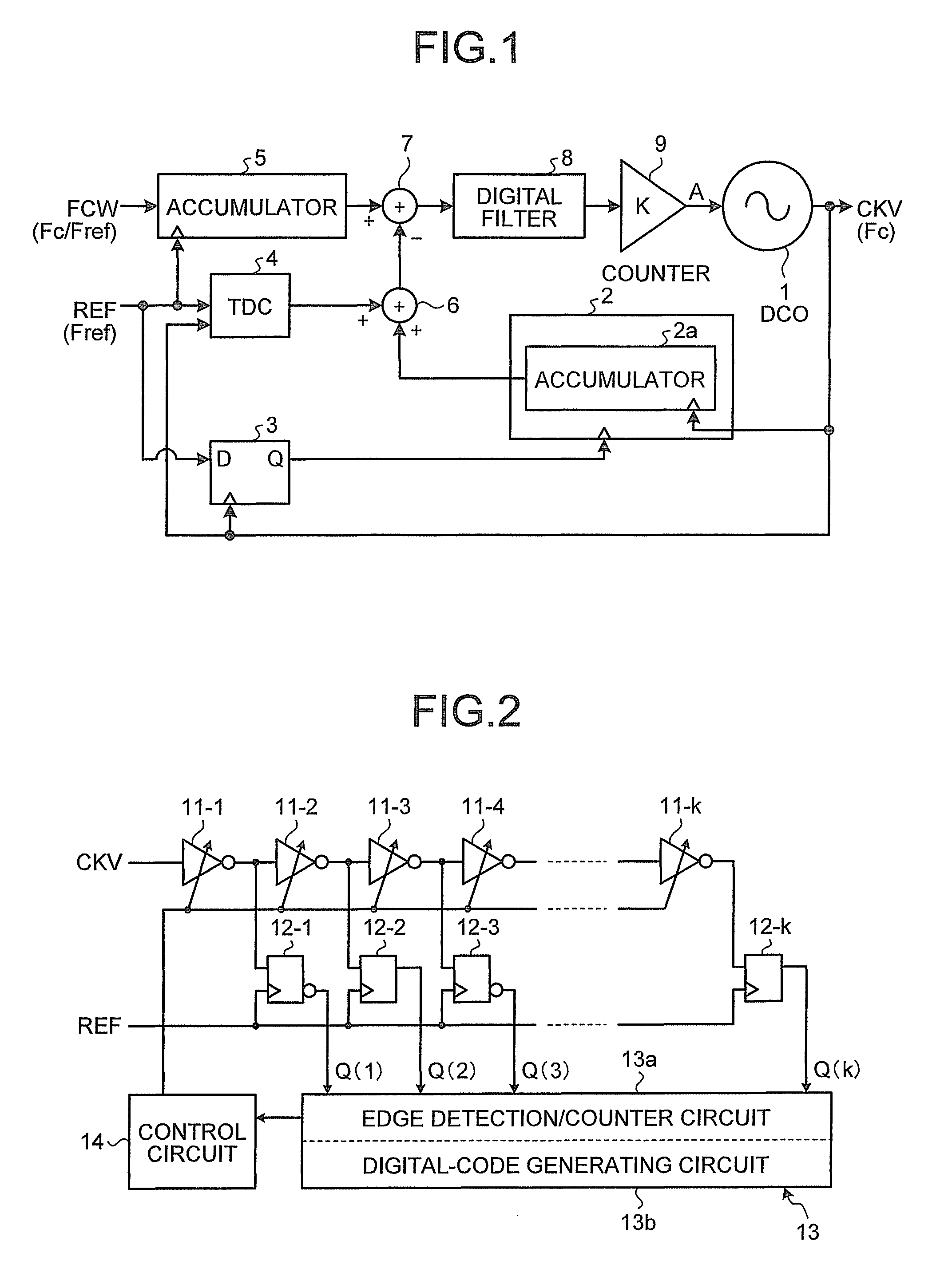Time to digital converter
a time-to-digital converter and converter technology, applied in the field of time-to-digital converter, can solve the problems of excessively bothersome adjustment work of delay time of tdc performed to acquire periodic data for each dco in use, unnecessarily increasing power consumption, and dulling of waveform
- Summary
- Abstract
- Description
- Claims
- Application Information
AI Technical Summary
Benefits of technology
Problems solved by technology
Method used
Image
Examples
first embodiment
[0031]FIG. 2 is a block diagram illustrating the configuration of a time to digital converter (TDC) according the present invention. In FIG. 2, a TDC according to this embodiment includes a plurality of variable delay circuits 11-1 to 11-k connected in series, a plurality of flip flops 12-1 to 12-k provided in a one-to-one relation with the variable delay circuits 11-1 to 11-k, an edge detection / counter circuit 13a, and a control circuit 14.
[0032]As the variable delay circuits 11-1 to 11-k, because a delay amount only has to be variable, widely-known variable delay circuits only have to be selected and used as appropriate. Because the variable delay circuits 11-1 to 11-k are shown in FIG. 2 as inverter circuits, a configuration example formed by a CMOS inverter circuit is shown in FIG. 3.
[0033]FIG. 3 is a circuit diagram illustrating a configuration example of the variable delay circuit shown in FIG. 2. In FIG. 3, in a PMOS transistor 17 and an NMOS transistor 18 connected in series...
second embodiment
[0043]FIG. 4 is a flowchart for explaining delay amount control operation of a time to digital converter according to the present invention. FIG. 5 is a timing chart for explaining an optimization process for delay time by a procedure shown in FIG. 4. In FIG. 5, a phase relation between the reference signal REF and the output CKV of the DCO 1, a relation between the output CKV of the DCO 1 and outputs of flip flops at certain delay time, and edge detecting operation are shown.
[0044]In the second embodiment, the edge detection / counter circuit 13a shown in FIG. 2 is set to detect and count, at the time of calibration, rising edges and falling edges of output signals of the flip flops 12-1 to 12-k. The control circuit 14 shown in FIG. 2 is set to monitor, at the time of calibration, the number of detected edges n to be three.
[0045]The reference signal REF and the output CKV of the DCO 1 shown in FIG. 2 are input, for example, in a phase relation shown in (1) of FIG. 5 and (2), (3), and...
third embodiment
[0051]FIG. 6 is a flowchart for explaining delay amount control operation of a time to digital converter according to the present invention. FIG. 7 is a timing chart for explaining an optimization process for delay time by a procedure shown in FIG. 6. In FIG. 7, as in FIG. 5, a phase relation between the reference signal REF and the output CKV of the DCO 1, a relation between the output CKV of the DCO 1 and outputs of flip flops at certain delay time, and edge detecting operation are shown.
[0052]In the third embodiment, the edge detection / counter circuit 13a shown in FIG. 2 is set to detect and count, at the time of calibration, one of rising edges and falling edges of output signals of the flip flops 12-1 to 12-k. In FIGS. 6 and 7, the edge detection / counter circuit 13a is set to detect and count the rising edges. The control circuit 14 shown in FIG. 2 is set to monitor, at the time of calibration, the number of detected edges n to be two.
[0053]The reference signal REF and the outp...
PUM
 Login to View More
Login to View More Abstract
Description
Claims
Application Information
 Login to View More
Login to View More - R&D
- Intellectual Property
- Life Sciences
- Materials
- Tech Scout
- Unparalleled Data Quality
- Higher Quality Content
- 60% Fewer Hallucinations
Browse by: Latest US Patents, China's latest patents, Technical Efficacy Thesaurus, Application Domain, Technology Topic, Popular Technical Reports.
© 2025 PatSnap. All rights reserved.Legal|Privacy policy|Modern Slavery Act Transparency Statement|Sitemap|About US| Contact US: help@patsnap.com



